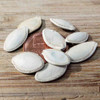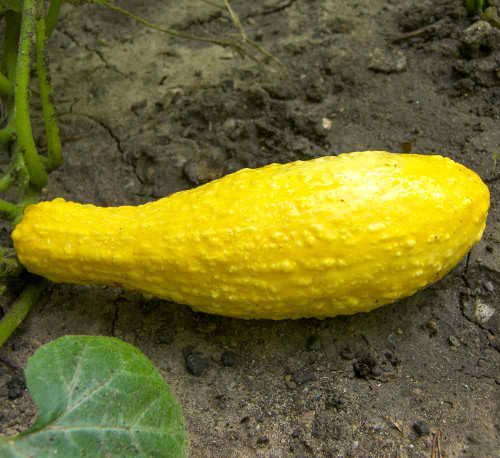Description
Black Beauty Zucchini - The Benchmark for Easy Summer Squash
Sometimes, an heirloom is so good and so dependable, that it becomes taken for granted and overlooked. That's often the case with Black Beauty Zucchini, a variety so reliable it has become a benchmark for home gardeners. And yet, those same heirlooms can defy expectations, as gardener Jack discovered testing varieties in Nevada's harsh high desert (Zone 5). He let some grow large and found something remarkable happened. Instead of becoming tough, the "flavor and texture IMPROVED," developing yellow flesh akin to spaghetti squash, perfect for grilling. At a neighborhood barbeque, these grilled slabs were "snatched up faster than the meat," earning praise as the "best zucchini they had ever tasted." Jack even dried much of his massive harvest for rich winter soups! This surprising resilience and unexpected culinary potential, offering exceptional quality even beyond the usual harvest window, is why time-tested, AAS-winning heirlooms like Black Beauty remain such invaluable garden performers.
Details
Black Beauty is a classic bush-type heirloom zucchini valued for consistent garden performance. This adaptable plant grows as an upright, open bush rather than a long vine, typically reaching 1 to 3 feet tall and 2 to 4 feet wide, making it suitable for traditional rows, raised beds, and even large containers without needing extensive support. Its sturdy stems produce large, typically lobed, heart-shaped leaves. It produces separate male and female large bright yellow or orange blossoms on the same plant, requiring bee activity for pollination to set fruit (including honey bees, squash bees, bumble bees).
It generally matures quickly, producing harvestable fruit 60-63 days from sowing, and performs well as a warm-season annual across USDA Zones 3-11.
Black Beauty zucchinis are best picked when 6 to 8 inches long and approximately 2 inches in diameter for optimal quality. They are cylindrical with exceptionally dark green, glossy skin that appears almost black. Inside, the flesh is creamy white, firm, and tender. Its eating quality is exceptional: the skin is famously thin, smooth, and tender, making peeling unnecessary!
History
The squash species is native to the Americas, with primary centers of origin identified in Mexico and the southern United States. It ranks among the oldest domesticated plant species, with archaeological evidence dating back 8,000 to 10,000 years. The Zucchini group, to which Black Beauty belongs, is a much more recent development, originating near Milan, Italy, in the mid-19th century from pumpkin or marrow types introduced earlier from the Americas. Early dark green, cylindrical zucchini types were likely introduced and grown in the US by the 1920s or 1930s.
Black Beauty emerged as a distinct variety, potentially from these Italian types. Its history became firmly established when a refined strain, developed by John Scarchuk at the Connecticut Agricultural Experiment Station, won the prestigious All-America Selections (AAS) award in 1957. This recognition solidified its reputation for quality and productivity based on mid-century standards, contributing to its status as an enduring, open-pollinated heirloom still valued today.
Uses
Black Beauty Zucchini is prized for its adaptability in the kitchen and mild, delicate, slightly sweet flavor that readily absorbs seasonings. It's ideal for numerous dishes, simplifying kitchen work considerably. Enjoy it raw, sliced thinly for salads, used as a fresh appetizer like vegetarian carpaccio, or served with dips.
It shines when cooked via grilling, steaming, sautéing, roasting, or baking into savory breads, casseroles, and gratins. Grated zucchini adds moisture and hidden nutrition to muffin or bread batter and can be used for vegetable pancakes or fritters. When sliced thinly lengthwise, it makes an excellent substitute for conventional noodles in pasta dishes. Larger, more mature squashes (though less tender) are perfectly sized for hollowing out and baking when stuffed with meats, cheeses, and grains. Don't forget the large, golden male blossoms – they are also edible and delicious when stuffed with soft cheeses and herbs, then battered and fried. Harvested zucchini also freezes well after blanching for later use.Whole, unwashed zucchini keep up to one week wrapped in the refrigerator crisper.
Companion Planting
Like other squash, Black Beauty benefits from plantings that attract pollinators, especially bees, which are essential for fruit set. Interplanting with flowers like borage, marigolds, or nasturtiums can draw bees and potentially beneficial predatory insects. Ensure good air circulation between plants.
It's wise to follow good crop rotation, keeping distance from other cucurbits (squash, melons, cucumbers) and avoiding planting near potatoes, which are often considered antagonistic.
Planting and Growing Tips
Black Beauty needs warm weather and requires full sun (6-8+ hours daily). Plant only after all danger of frost and soil is consistently warm (70-85°F ideal for germination). It requires rich, fertile, well-drained soil; amending generously with compost is crucial for these heavy feeders. Direct sowing seeds ½ to 1 inch deep is preferred. Plant in rows or hills, thinning to the strongest plants spaced 18-36 inches apart – ample spacing is vital for air circulation. Germination is usually rapid (5-10 days) in warm soil.
Consistent moisture is key, especially during flowering/fruiting (aim for ~1 inch/week). Water deeply at the soil level to keep foliage dry and help prevent fungal diseases. Cucumbers are heavy feeders; supplement initial compost with side-dressings (balanced fertilizer or compost tea) once vines run and during peak production, avoiding excessive nitrogen early on. Mulch heavily. Keep weeded, especially when young, cultivating shallowly. While generally bushy, taller plants may benefit from light support installed early. Issues like observing only male flowers first can sometimes relate to plant stress.
Potential Challenges & Management: As a traditional heirloom, Black Beauty can be susceptible to common cucurbit issues. Be vigilant for Squash Vine Borers (check bases, consider wraps), Squash Bugs (handpick, destroy eggs), and Cucumber Beetles (can transmit wilt; row covers useful pre-flower). Powdery Mildew is also common; prioritize prevention (sun, spacing, base watering) and use organic options (neem, milk spray) promptly if needed. Crop rotation (3+ years) and garden cleanup are essential.
Harvesting Tips
Harvest Black Beauty zucchini frequently! Pick fruits when 6 to 8 inches long (or smaller) while skin is glossy and tender, before seeds enlarge. Oversized zucchini lose quality. Use a knife or pruners to cut the stem cleanly, leaving about an inch attached. Check plants daily or every other day in peak season. Consistent harvesting encourages more production. Harvest edible male blossoms in the morning. Store unwashed zucchini wrapped in the refrigerator crisper.
Learn More
From the soil to the seed to the food you eat - we'll help you grow your best garden!
2 Reviews
-
Best Zucchini for Grilling/Drying
True to the description, we harvested the first fruit 61 days after sowing. Excellent, steady production through a few early touches of frost. We grew this out in our test garden and harvested at various stages of maturity. At 6-8 inches this is a delicious, typical zucchini. However, this squash surprised us because the flavor and texture improved as we allowed the fruits to grow beyond 20 and even 30 inches. The flesh became yellow with a texture similar to spaghetti squash. Cooked on the grill at a neighborhood barbeque the slabs of squash were snatched up faster than the meat. People kept coming back for more, exclaiming that it was the best zucchini they had ever tasted. We agree. We harvested about 200 pounds of squash per bush and have dried much of it for winter soups. When reconstituted in the soup, the flavor is rich and delicious. Conditions: northern Nevada high desert, USDA zone 5, organic production on hugelbed/swale with 1/2 inch composted goat manure top dressing and daily overhead watering.
-
Simply the Best
Black Beauty squash is my favorite squash bar none. The flavor is superb any way you want to eat it. I like to let mine get at least 20 inches long before picking them but whether you pick them small or huge they stay sweet and delicious. It is also the easiest squash to grow and a very reliable producer year in and year out. I love patty pan and delicata squash as well but Black Beauty is the only squash I grow every year.



















